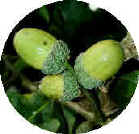| 1.
Flowering plants grow from seeds. Seeds contain a tiny embryo plant, together with stored
food reserves. The seed is surrounded by a tough coat which protects it. |

|
2. Different kinds of plants produce different
kinds of seeds. The seeds are often carried to new places away from the parent plant. Some
may be blown by the wind, others may be carried by water and others by birds or
other animals. |
| 5.
Once plants are adult, they can begin to produce flowers. This may take only a few weeks
for plants such as grasses, or many years for plants such as Oak trees. Flowers contain
male and female parts. In most plants, these are both together in the same flowers.
However, in some, they are in separate flowers on the same plant (Hazel). Some species may
have separate male and female plants (Holly). NEXT |

|
4. The first two leaves of a seedling often
look different to the adult leaves. They are green and as soon as they open in the light,
the little seedling can begin to make its own food. It then no longer needs to use the
food reserves in the seed. The seedling makes its own food using water, carbon dioxide
from air and light, in a process known as photosynthesis. |